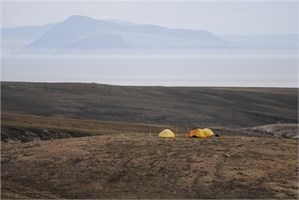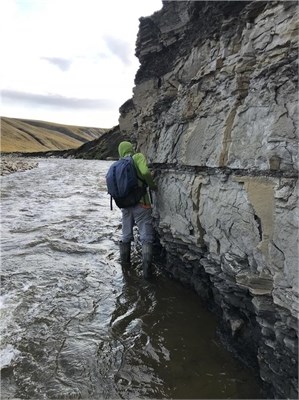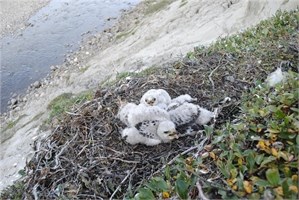Collaborative Raptor Research on Bylot Island Further Proves Climate Change
Posted on September 24, 2019 in Science

Over 2,000 miles separate Hawk Mountain Sanctuary and the Bylot Island Migratory Bird Sanctuary of Nunavut, Canada, but studies conducted in this remote location are helping us better understand the conservation of raptors we see daily.
The effects of climate change can be seen worldwide in extreme weather conditions, be they hotter summers, harsher winters, drier draughts, longer wet seasons, and more. Within the Arctic Circle, temperatures have seen an average increase of 2°C in the summer and 4°C in the winter. This leads to wetter conditions, which can spell disaster for birds of prey as well as their food sources.
While much of the Arctic has very low biodiversity, Bylot Island is a diverse hotspot, home to over 71 species of birds throughout the year. This makes the area incredibly important for conservation research.

Unfortunately, increased warming in the Arctic has led to wetter conditions in the lemmings’ winter homes. According to Gilles Gauthier, director of the Bylot Island research station and member of the Centre d’études nordiques, the “presence of liquid water in the base snow layer negatively affects winter population growth of lemmings.” This winter population growth is crucial in maintaining the population cycle for these animals. Every 3-4 years, there is a normal population crash among lemmings in late summer, as the food source boom leads to a feeding frenzy by predators like snowy owls, peregrine falcons, rough-legged hawks, weasels, arctic foxes, and red foxes.
As the lemmings reach their peak population density, predators consume them at astonishing rates, killing about 12% of collared lemmings and 7-8% of brown lemmings daily. In the years when the lemming population crashes, many of these hunters will skip breeding altogether due to resource scarcity. A high density of lemming winter nests means a population boom, which leads to a high density of summer nests for raptors.

Not only does the changing climate impact the nests of raptors’ food sources, but it also negatively affects the nests of raptors themselves. Rough-legged hawks possess a high level of site fidelity when it comes to nesting, especially in the winter, meaning that these birds return to use the same nests from year to year. This makes the integrity of a nest very important. After an episode of heavy rain, researchers found the collapsed nest of a rough-legged hawk and the body of a chick; when there is more than 7 mm of rainfall in this usually dry environment, these nests become vulnerable.
Another factor in nest destruction is the substrate type that a nest is built on. This alone is a good predictor of the survival of a nest. Increasingly warmer summers mean that layers of permafrost melt, making conditions wet so that sedimentary rock easily shifts beneath nests. These instances of unconsolidated rock are an even greater risk to nest survival.
There is some positive news to turn to, despite the alarm caused by changing northern environments. With the help of satellite tracking, researchers, like our own Dr. Therrien, can follow the annual movements of raptors like snowy owls, whose two main mating sites are Bylot Island and Deception Bay, Quebec. This technology, through monitoring 21 individuals, has taught us that while these are the two main sites, there is an average change of 700 km for breeding grounds from year to year. Tracking has also shown that 80% of localizations remain in the Arctic during winter, with 46% of those in the marine environment. Previously, these birds were not considered marine predators, but data now shows that snowy owls move to polynyas, areas of sea ice where birds stay year-round in high latitude zones, to feast on the dense populations of smaller sea birds.
Both findings exemplify the resourcefulness of snowy owls and their ability to adapt to unreliable food cycles, but that does not mean that irregular population cycles in lemmings are not a danger to the species.
In the process of studying the Arctic environment and the multitude of factors that affect the success of birds of prey, researchers seek to study further the movement of birds, vulnerability of nesting sites, and reproductive success versus lemming abundance.
To help support Hawk Mountain’s efforts in Arctic raptor research, please contact Dr. JF Therrien at 570-943-3411 ext. 104 or [email protected].